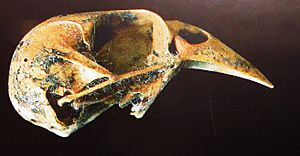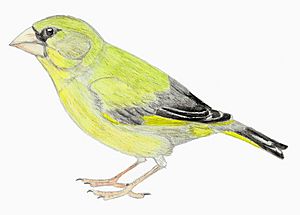Trias greenfinch facts for kids
Quick facts for kids Trias greenfinchTemporal range: Late Pleistocene to Early Holocene
|
|
|---|---|
 |
|
| Skull | |
| Scientific classification | |
| Genus: |
Chloris
|
| Species: |
triasi
|
| Synonyms | |
|
Carduelis triasi |
|
The Trias greenfinch (Chloris triasi) was a type of finch bird that is now extinct. It belonged to the finch family, Fringillidae. Scientists found its fossil remains in the Cuevas de los Murciélagos (which means "Caves of the Bats") near San Andrés y Sauces. This area is in the northern part of La Palma, one of the Canary Islands. The bird was named after a Spanish scientist, Miquel Trías, who helped find the first fossils in 1985.
Contents
What the Trias Greenfinch Looked Like
Scientists found many fossil parts of the Trias greenfinch. The main fossil, called the holotype, is a nearly complete skull. Other fossils, called paratypes, include pieces of its wing bones (like the humerus, ulna, and carpometacarpus).
The skull of the Trias greenfinch was about 3.5 centimeters long. Its upper beak was about 1.9 centimeters long. The wing bone called the carpometacarpus was about 1.2 centimeters long.
The Trias greenfinch was a close relative of the European greenfinch (Chloris chloris), which is still alive today. However, the Trias greenfinch had a bigger and wider head. Its beak was also about 30 percent larger than its European cousin's.
Its legs were very long and strong. But its wings were shorter compared to the European greenfinch. Scientists think these shorter wings might have helped it spend more time on the ground in the laurel forests where it lived.
Diet and Habits of the Trias Greenfinch
The large beak of the Trias greenfinch gives us a clue about its diet. Scientists believe it mainly ate large seeds.
Its shorter wings likely meant it was not a very strong flyer. This was probably not a problem for the bird because there were no natural predators on La Palma at that time. This meant it did not need to fly away quickly to escape danger.
When the Trias Greenfinch Disappeared
The fossils of the Trias greenfinch come from layers of rock that are from the Late Pleistocene period. This was a long time ago, during the last Ice Age.
However, the Trias greenfinch likely became extinct later, in the early Holocene period. This was when the first human settlers arrived on the Canary Islands. These settlers brought new animals with them, such as cats and rats. These new animals might have hunted the Trias greenfinch or competed with it for food, leading to its disappearance.
See also
 In Spanish: Verderón de Trías para niños
In Spanish: Verderón de Trías para niños


